- Преподавателю
- Иностранные языки
- Творческий проект, страноведческий материал История Елизаветы Английской
Творческий проект, страноведческий материал История Елизаветы Английской
| Раздел | Иностранные языки |
| Класс | 10 класс |
| Тип | Другие методич. материалы |
| Автор | Корчагина Е.И. |
| Дата | 14.02.2016 |
| Формат | doc |
| Изображения | Есть |
ОТДЕЛ ОБРАЗОВАНИЯ ПЕТРОВСКОГО РАЙОНА Г, ДОНЕЦКА
ТВОРЧЕСКИЙ ПРОЕКТ

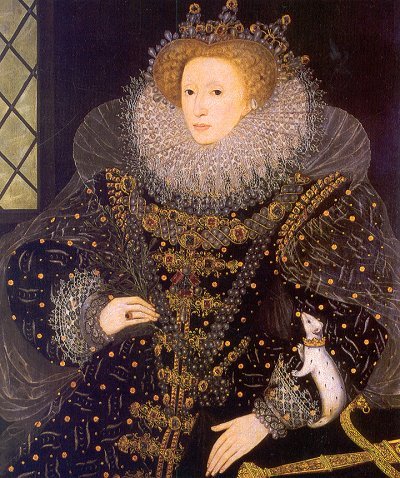
Корчагина Е.И.
Учитель английского языка
T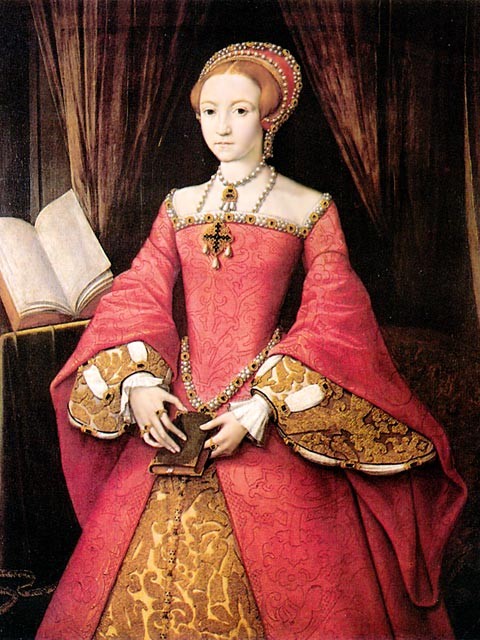 he reign of Queen Elizabeth I is often referred to as The Golden Age of English history. Elizabeth was an immensely popular Queen, and her popularity has waned little with the passing of four hundred years. She is still one of the best loved monarchs, and one of the most admired rulers of all time. She became a legend in her own lifetime, famed for her remarkable abilities and achievements. Yet, about Elizabeth the woman, we know very little. She is an enigma, and was an enigma to her own people.
he reign of Queen Elizabeth I is often referred to as The Golden Age of English history. Elizabeth was an immensely popular Queen, and her popularity has waned little with the passing of four hundred years. She is still one of the best loved monarchs, and one of the most admired rulers of all time. She became a legend in her own lifetime, famed for her remarkable abilities and achievements. Yet, about Elizabeth the woman, we know very little. She is an enigma, and was an enigma to her own people.
E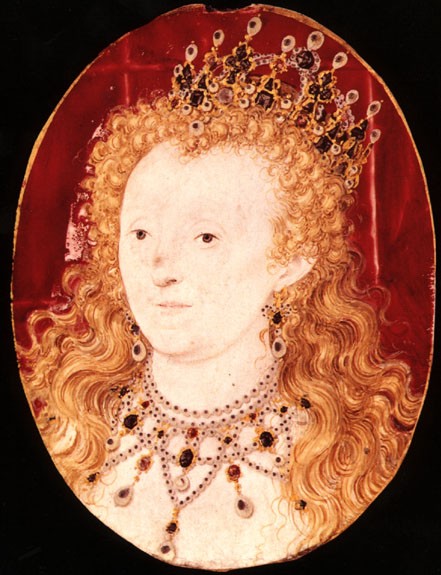 lizabeth was the daughter of King Henry VIII and his second wife, Anne Boleyn. She was born on 7 September 1533 at Greenwich Palace. Her birth was possibly the greatest disappointment of her father's life. He had wanted a son and heir to succeed him as he already had a daughter, Mary, by his first wife, Katherine of Aragon. He had not divorced Katherine, and changed the religion of the country in the process, to have only another daughter. Elizabeth's early life was consequently troubled. Her mother failed to provide the King with a son and was executed on false charges of incest and adultery on 19 May 1536. Anne's marriage to the King was declared null and void, and Elizabeth, like her half-sister, Mary, was declared illegitimate and deprived of her place in the line of succession.
lizabeth was the daughter of King Henry VIII and his second wife, Anne Boleyn. She was born on 7 September 1533 at Greenwich Palace. Her birth was possibly the greatest disappointment of her father's life. He had wanted a son and heir to succeed him as he already had a daughter, Mary, by his first wife, Katherine of Aragon. He had not divorced Katherine, and changed the religion of the country in the process, to have only another daughter. Elizabeth's early life was consequently troubled. Her mother failed to provide the King with a son and was executed on false charges of incest and adultery on 19 May 1536. Anne's marriage to the King was declared null and void, and Elizabeth, like her half-sister, Mary, was declared illegitimate and deprived of her place in the line of succession.
The next eight years of Elizabeth's life saw a quick succession of stepmothers. There was Jane Seymour who died giving birth to the King's longed for son, Edward; Anne of Cleves who was divorced; Catherine Howard who was beheaded; and finally Catherine Parr. For generations, historians have debated whether the constant bride changing of her father was responsible for Elizabeth's apparent refusal to marry. It is certainly possible that the tragic fates of Anne Boleyn and Catherine Howard i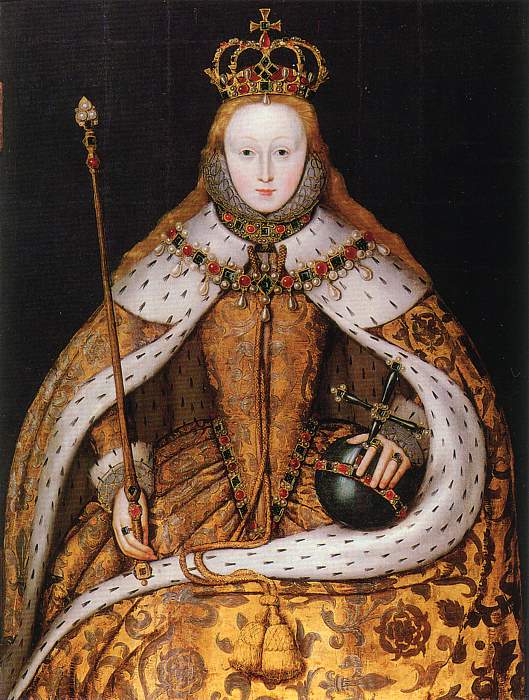 mpressed upon her a certain fear of marriage, but there may have been other reasons for the Queen's single state, such as a fear of childbirth, which claimed the lives of a significant number of women in this period. Even if the Queen had no personal reservations about marriage, there were political problems with almost every contender for her hand. Religion was a major divisive issue, and there was also the problem of whether Elizabeth would have to relinquish any of her royal powers to a husband in an age when the political sphere was exclusively male .
mpressed upon her a certain fear of marriage, but there may have been other reasons for the Queen's single state, such as a fear of childbirth, which claimed the lives of a significant number of women in this period. Even if the Queen had no personal reservations about marriage, there were political problems with almost every contender for her hand. Religion was a major divisive issue, and there was also the problem of whether Elizabeth would have to relinquish any of her royal powers to a husband in an age when the political sphere was exclusively male .
E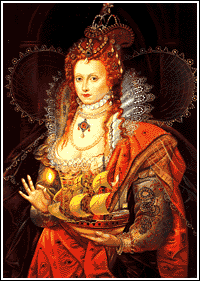 lizabeth was crowned Queen on Sunday 15th January 1559. In the months that followed, the new Queen reestablished the Protestant Church in England and restored the debased coinage. Perhaps to appease Catholics or to appease those who did not believe a woman could become head of the church, Elizabeth became Supreme Governor of the Church of England, rather than Supreme Head as her father had been. While it is impossible to know what exactly the Queen's personal religious beliefs were, the Church she established is an indication of them. She was a committed Protestant, and reputedly spent time in prayer every day, but she was probably a conservative Protestant. She liked candles and crucifixes in her private chapel, liked church music, and enjoyed the more traditional style of worship in contrast to the sermon based service that was becoming popular in some Protestant circles. She did not like religious extremism and did not want to persecute any of her people for their religious beliefs. However, the tenacious political nature of the Catholic/Protestant split meant that her government had to take a harsher line towards Catholics than she wanted.
lizabeth was crowned Queen on Sunday 15th January 1559. In the months that followed, the new Queen reestablished the Protestant Church in England and restored the debased coinage. Perhaps to appease Catholics or to appease those who did not believe a woman could become head of the church, Elizabeth became Supreme Governor of the Church of England, rather than Supreme Head as her father had been. While it is impossible to know what exactly the Queen's personal religious beliefs were, the Church she established is an indication of them. She was a committed Protestant, and reputedly spent time in prayer every day, but she was probably a conservative Protestant. She liked candles and crucifixes in her private chapel, liked church music, and enjoyed the more traditional style of worship in contrast to the sermon based service that was becoming popular in some Protestant circles. She did not like religious extremism and did not want to persecute any of her people for their religious beliefs. However, the tenacious political nature of the Catholic/Protestant split meant that her government had to take a harsher line towards Catholics than she wanted.
N ow that Elizabeth was Queen, proposals of marriage flooded in, but Elizabeth committed herself to none of them. In a genius of political wheeling and dealing, she managed to use her single state to benefit the country by using the bait of marriage to draw in enemies, or to frighten them by suggesting she would marry one of their foes. Whatever Elizabeth's personal feelings towards marriage, on two occasions she did come close to matrimony. For many years, the most serious contender for her hand was Robert Dudley, created Earl of Leicester jn 1564. He and Elizabeth had known each other for years and had been imprisoned in the Tower of London at the same time. He was the only serious personal love interest of the Queen's life. Politically, however, marrying him would have been a disaster. He was unpopular as he was the son of the traitor Northumberland, and was loathed even more after his wife was found dead in mysterious circumstances. It was thought he had murdered her so he would be free to marry Elizabeth. The other serious contender for the Queen's hand was Francis, Duke of Alencon/Anjou, heir to the French throne. But again, political considerations made the match ultimately impossible.
ow that Elizabeth was Queen, proposals of marriage flooded in, but Elizabeth committed herself to none of them. In a genius of political wheeling and dealing, she managed to use her single state to benefit the country by using the bait of marriage to draw in enemies, or to frighten them by suggesting she would marry one of their foes. Whatever Elizabeth's personal feelings towards marriage, on two occasions she did come close to matrimony. For many years, the most serious contender for her hand was Robert Dudley, created Earl of Leicester jn 1564. He and Elizabeth had known each other for years and had been imprisoned in the Tower of London at the same time. He was the only serious personal love interest of the Queen's life. Politically, however, marrying him would have been a disaster. He was unpopular as he was the son of the traitor Northumberland, and was loathed even more after his wife was found dead in mysterious circumstances. It was thought he had murdered her so he would be free to marry Elizabeth. The other serious contender for the Queen's hand was Francis, Duke of Alencon/Anjou, heir to the French throne. But again, political considerations made the match ultimately impossible.
N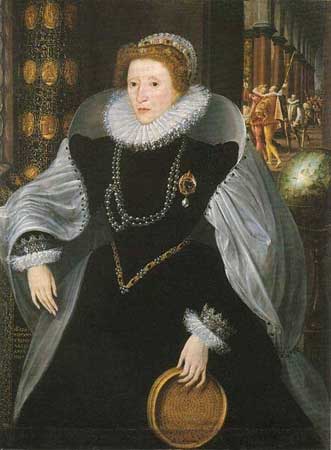 ot marrying and having a child of her own meant that the succession was unsettled. Elizabeth did not like to talk about the succession and tried to have talk of it suppressed, but people were anxious about what would happen to the country when she died. However, having a child of her own may not have been an end to all problems. In the eyes of Catholics, Elizabeth was illegitimate and had no right to the throne. To them, Mary, Queen of Scots was the rightful Queen of England. Plots were made to make Mary queen and these would have been formed regardless of whether Elizabeth had a child or not. This is perhaps especially so when Mary was Elizabeth's prisoner following her disastrous reign in Scotland.
ot marrying and having a child of her own meant that the succession was unsettled. Elizabeth did not like to talk about the succession and tried to have talk of it suppressed, but people were anxious about what would happen to the country when she died. However, having a child of her own may not have been an end to all problems. In the eyes of Catholics, Elizabeth was illegitimate and had no right to the throne. To them, Mary, Queen of Scots was the rightful Queen of England. Plots were made to make Mary queen and these would have been formed regardless of whether Elizabeth had a child or not. This is perhaps especially so when Mary was Elizabeth's prisoner following her disastrous reign in Scotland.
F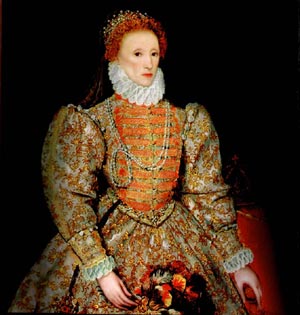 orced to flee her own country, having abdicated her throne in favor of her son, she landed in England, seeking Elizabeth's help in restoring her to her kingdom. She was immediately imprisoned. This was as much to protect her as to minimize the danger she posed to Elizabeth. Mary was kept a prisoner for almost twenty years. In that time, Elizabeth refused to hear about executing her cousin, but Mary's complicity in the Babington plot of 1586 made the execution, in the eyes of many, unavoidable. It was a traumatic time for Elizabeth, and for a while it seemed that she would not have the strength to go ahead with the execution, but she did, and Mary was executed at Fotheringay Castle on 8 February 1587.
orced to flee her own country, having abdicated her throne in favor of her son, she landed in England, seeking Elizabeth's help in restoring her to her kingdom. She was immediately imprisoned. This was as much to protect her as to minimize the danger she posed to Elizabeth. Mary was kept a prisoner for almost twenty years. In that time, Elizabeth refused to hear about executing her cousin, but Mary's complicity in the Babington plot of 1586 made the execution, in the eyes of many, unavoidable. It was a traumatic time for Elizabeth, and for a while it seemed that she would not have the strength to go ahead with the execution, but she did, and Mary was executed at Fotheringay Castle on 8 February 1587.
R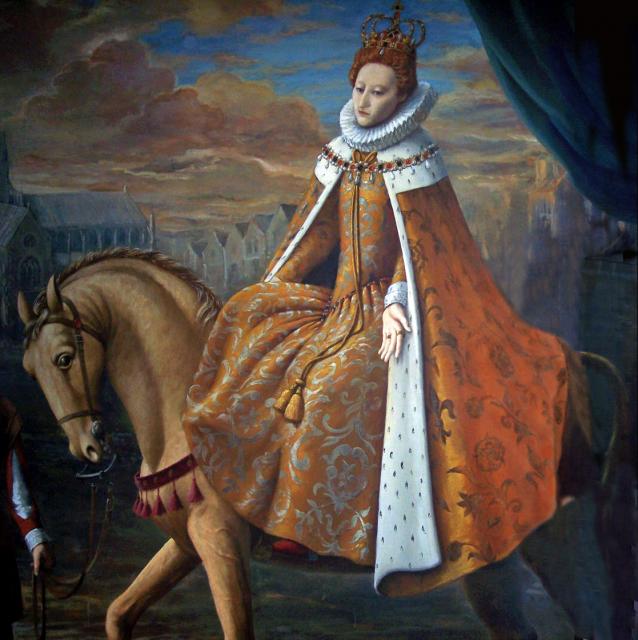 elations between Elizabeth and Philip, now King of Spain, had begun amicably, but had deteriorated over the years as their different political and religious agendas clashed. By 1588 they were enemies of the first-rate. Philip had spoken of invading England and dethroning Elizabeth for years but the execution of the Queen of Scots gave him an added incentive. Now he could claim the English throne for himself and not for her. In the summer of 1588 he sent his mighty fleet against England. But by superior tactics, ship design, and sheer good fortune, the English defeated them. Elizabeth's popularity reached its zenith. It was also another personal triumph as she had proved that she, a woman, could lead in war as well as any man.
elations between Elizabeth and Philip, now King of Spain, had begun amicably, but had deteriorated over the years as their different political and religious agendas clashed. By 1588 they were enemies of the first-rate. Philip had spoken of invading England and dethroning Elizabeth for years but the execution of the Queen of Scots gave him an added incentive. Now he could claim the English throne for himself and not for her. In the summer of 1588 he sent his mighty fleet against England. But by superior tactics, ship design, and sheer good fortune, the English defeated them. Elizabeth's popularity reached its zenith. It was also another personal triumph as she had proved that she, a woman, could lead in war as well as any man.
Elizabeth was only fifteen years old, but one careless word from her could have sealed the fate of all those who were dear to her, and possibly have cost her her own life as well (although it is doubtful that Elizabeth's death was the object of the government, their main concern being to condemn the Admiral).
I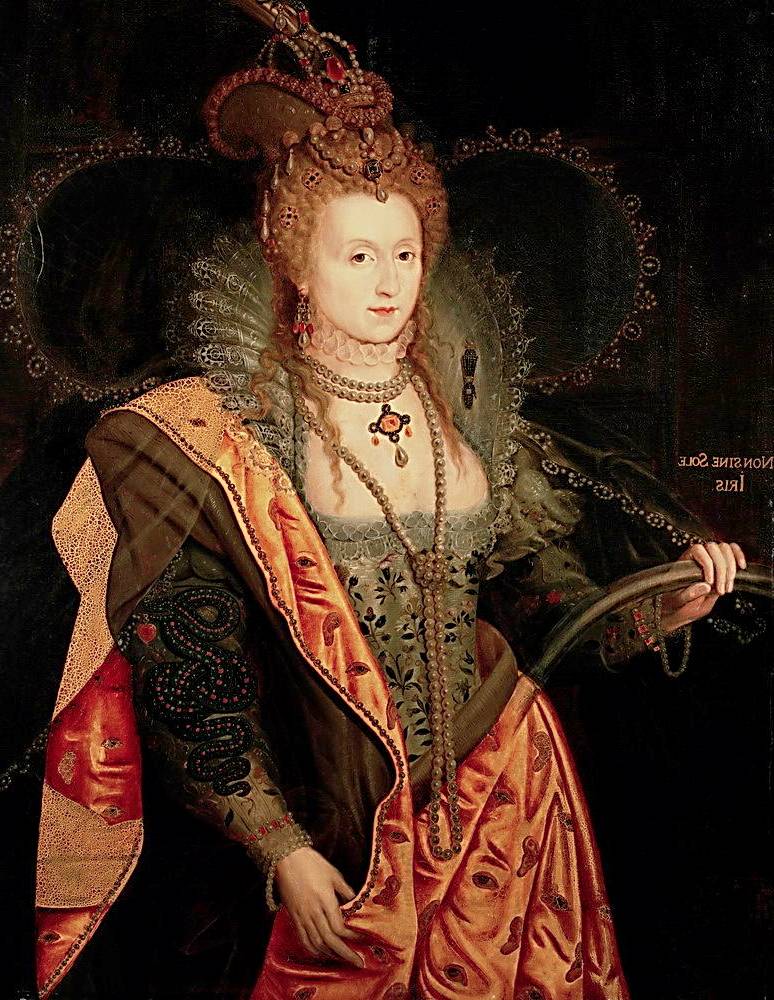 n such extremely difficult, and what must have been very frightening, circumstances, and with virtually no assistance, Elizabeth managed to uphold her innocence. The Admiral, however, was found guilty of high treason and condemned to death. The affect of all this on Elizabeth must have been immense. Certainly it took its toll emotionally and physically, and Elizabeth was unwell for some months after. However, as well as affecting her health, it also effected her reputation and this was a great concern to Elizabeth as well. She was always very sensitive about what people thought of her, and she wanted the rumor that she was pregnant by the Admiral suppressed. She wrote to the Protector asking for a proclamation to be made saying these things were untrue. But while this was considered, it was not implemented. During the investigation, Elizabeth had been painfully parted from her governess, and it was sometime before they were reunited.
n such extremely difficult, and what must have been very frightening, circumstances, and with virtually no assistance, Elizabeth managed to uphold her innocence. The Admiral, however, was found guilty of high treason and condemned to death. The affect of all this on Elizabeth must have been immense. Certainly it took its toll emotionally and physically, and Elizabeth was unwell for some months after. However, as well as affecting her health, it also effected her reputation and this was a great concern to Elizabeth as well. She was always very sensitive about what people thought of her, and she wanted the rumor that she was pregnant by the Admiral suppressed. She wrote to the Protector asking for a proclamation to be made saying these things were untrue. But while this was considered, it was not implemented. During the investigation, Elizabeth had been painfully parted from her governess, and it was sometime before they were reunited.
I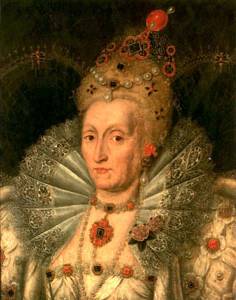 n these troubled years, Elizabeth's relationship with her brother suffered. They were no longer as close as they had been, and during and immediately after the Seymour scandal, Elizabeth was forbidden to attend court. She was eventually allowed to return, however. To try and recapture her virginal image, Elizabeth dressed as the perfect Protestant lady. She wore plain black and white gowns, refused to decorate herself with jewelry and other finery, and refused to wear make up. Her sobriety was much commented upon, and even her brother called her "sweet sister temperance".
n these troubled years, Elizabeth's relationship with her brother suffered. They were no longer as close as they had been, and during and immediately after the Seymour scandal, Elizabeth was forbidden to attend court. She was eventually allowed to return, however. To try and recapture her virginal image, Elizabeth dressed as the perfect Protestant lady. She wore plain black and white gowns, refused to decorate herself with jewelry and other finery, and refused to wear make up. Her sobriety was much commented upon, and even her brother called her "sweet sister temperance".
Following the disgrace and death of his brother, Thomas, Edward Seymour was replaced as Protector by John Dudley, Earl of Warwick, soon to be the Duke of Northumberland. He was the father of Elizabeth's childhood friend, Robert Dudley, and they may have seen each other a number of times during the Duke's government.
E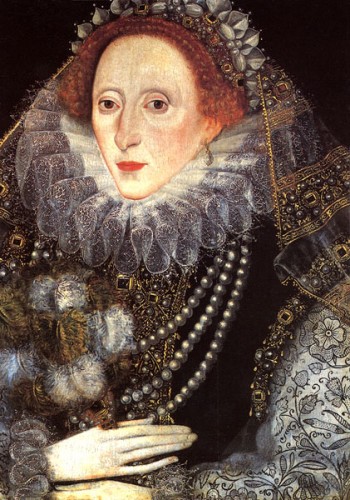

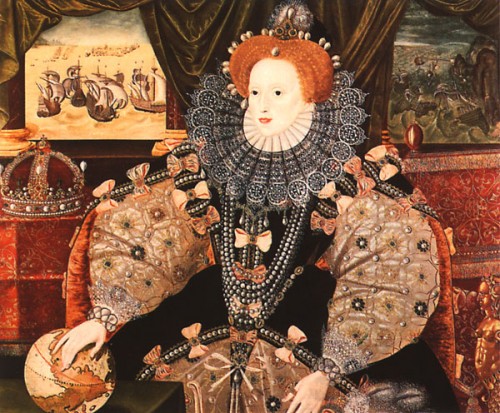 lizabeth was dedicated to her country in a way few monarchs had been or have been since. Elizabeth had the mind of a political genius and nurtured her country through careful leadership and by choosing capable men to assist her, such as Sir William Cecil and Sir Francis Walsingham. Elizabeth was a determined woman, but she was not obstinate. She listened to the advice of those around her, and would change a policy if it was unpopular. In appearance she was extravagant, in behavior sometimes flippant and frivolous, but her approach to politics was serious, conservative, and cautious. When she ascended the throne in 1558, England was an impoverished country torn apart by religious squabbles When she died at Richmond Palace on the 24th March 1603, England was one of the most po werful and prosperous c ountries in the world.
lizabeth was dedicated to her country in a way few monarchs had been or have been since. Elizabeth had the mind of a political genius and nurtured her country through careful leadership and by choosing capable men to assist her, such as Sir William Cecil and Sir Francis Walsingham. Elizabeth was a determined woman, but she was not obstinate. She listened to the advice of those around her, and would change a policy if it was unpopular. In appearance she was extravagant, in behavior sometimes flippant and frivolous, but her approach to politics was serious, conservative, and cautious. When she ascended the throne in 1558, England was an impoverished country torn apart by religious squabbles When she died at Richmond Palace on the 24th March 1603, England was one of the most po werful and prosperous c ountries in the world.


